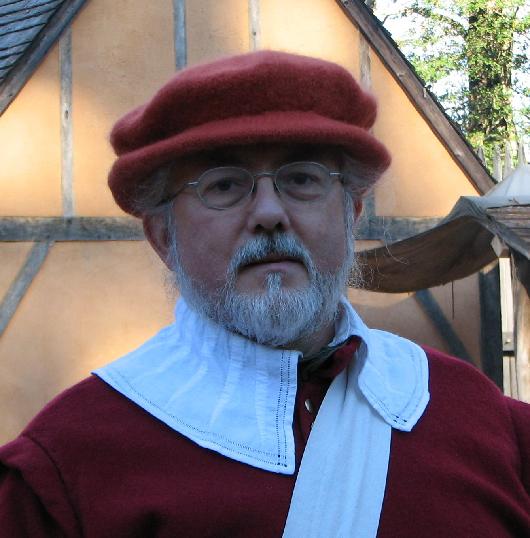This is the page for non-reproduction clothes and accessories (that aren't on the embroidery page) that were entirely hand-sewn from start to finish. Most of them use period threads and materials, but not all.
|
This is the first pair of gloves I ever made. They're grey wool, and they were modified from a commercial pattern. While mostly okay, the modern glove patterns use a different method for creating the thumb than 16th century gloves.
Wrist length gloves do show up in some pictures, but if I ever make my own gloves again, I think I'd make them slightly longer.
...Not to mention actually use a period pattern.
|
This is a linen needle-lace falling band I made about ten years ago. The pleats on the band are stitched down, which gives the collar a much smoother look. The lace was sewn with DMC embroidery thread as that was what I had on hand - the whole thing was made with materials I had around the house.
If I ever do a needlelace collar again (and I might), I'll make it from linen thread - practice pieces have shown that the lace lies much flatter and doesn't want to curl as much.
My extremely amateur skills with needlelace have improved a little since this was done - this was my first attempt at sewn lace.
|
Another falling band made using the same stitched-down pleating technique, this one with a double handkerchief-stitch hem. The narrow collar band is turned under and ironed into place, and the band is pinned to the inside of the doublet neck.
Here it is easier to see the stitching on the pleats, as the whole thing is medium-grade linen, including the thread. This was made for wear when volunteering at the Jamestown Settlement Museum.
The great thing about stitching down the pleats completely instead of just gathering the band into the collar is that it lies really well against the neck - this one curves neatly around the neck and then flows out over the shoulders without bunching up at all, even in the rain (though the linen got a bit wrinkly).
|
 |
| The falling band in action - Jamestown, November 2006 |
|
|
My green wool bodies I wear at Jamestown. The stitching is done in brown linen thread, and it's boned with willow (osier) reeds. Some of the stitching is channels for the reeds, some is just decorative. I bound the armholes and the waist with extra wool for reinforcement. The bodies are lined with beige linen.
This was my first hand-stitched pair of bodies - i found that while the hand-stitched channels were more time consuming to sew, the stitching worked better than if they were done on a machine. The channels were easier to fit to the reed, since I could stitch each reed in as I sewed, rather than measuring and guessing. This meant the reeds sat closer together and worked better.
|
Dark grey wool jacket with vertical green stripes. This jacket essentially cost me nothing to make, since I used the wool from a skirt that shrank, and lined it in red linen left over from another project.
Like the maidstone jacket, I made this one using the correct seaming technique, and it made a huge difference.
|
Yellow wool petticoat with bias tape trim (I did this one a while ago). It's now rather authentically moth-eaten, as it was stored in an attic for a while.
This might be the first completely hand-sewn thing I ever made, I don't remember. I laid out the entire trim design and sewed it on before I cartridge-pleated the skirt, and originally it was open in front. I didn't wear it much for years, since I'd miscalculated and made it too long, and it tripped me when I walked. I put off fixing it because I thought I'd have to unpick the entire design and re-sew it if I shortened it, but further research I did during writing the second hand clothing article convinced me that if it had been bought and shortened by someone back then, they'd have just cut the bottom two inches off and re-sewn the guard (the trim on the edge of the hem), so that's what I did.
It worked wonderfully, and now I have a nice wool skirt. Next, I plan to get matching wool thread and darn the moth holes.
Honestly, I am a big fan of wearing one's clothes out - a new outfit was a special thing for most Elizabethans, and even Queen Elizabeth had her clothes re-made from time to time to keep up with fashion. At the middle class level, discreet patches and mendings were not unusual, and an outfit might be re-made several times over its lifespan.
|
The thumbnails below are hand-sewn garments that are detailed elsewhere on the site:
From left to right - red silk jacket , the Maidstone jacket, and orange silk petticoat, and red wool petticoat.
|
|